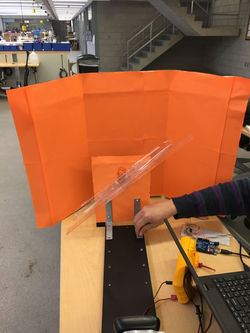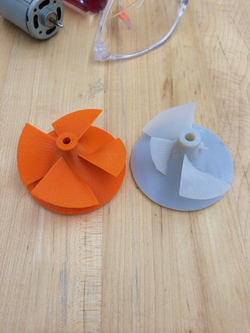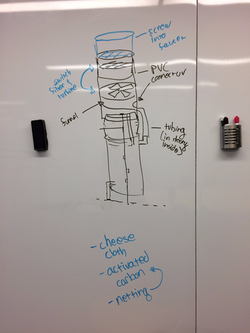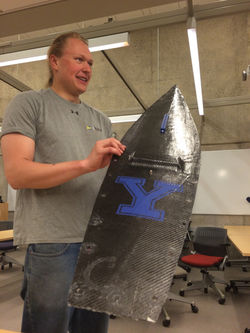The Beth-el Center:
Reducing Childhood Trauma in Homeless Shelters
Engineering Project Portfolio
My Work and Expertise
I am part of the Computer Aided Engineering group for Harley Davidson Engineering. I work primarily with Finite Element Analysis software and hand calculations to evaluate the structural integrity of a variety of parts - anything and everything you might find on a motorcycle! I help validate proof of concept designs, and then refine the final design for weight savings. This often includes changing geometry to reduce high stress areas, increasing stiffness using ribs and giving material suggestions.
My process starts by creating a free body diagram, and working through basic static equations using a simplified version of the model. I then move onto using more complex software such as Abaqus or Hypermesh (depending on the meshing techniques required) to preform a more sophisticated analysis.
My Current Work Often Includes:
-
Engine vibration analysis
-
Basic impact analysis
-
Static analysis and some non-linear analysis
-
Rib design, improving stiffness of parts
-
Modal analysis
-
Topology Optimization (using Abaqus or Inspire)
-
Determining Strain Gage Location
-
Basic stiffness tests
Software Expertise:
-
Abaqus (Finite Element Analysis)
-
HyperMesh (Finite Element Analysis primarily for shell elements and thin parts)
-
Simulink (designing and testing control systems)
-
Inspire (topology optimization)
 |  |
|---|---|
 |  |
 |  |
 |  |
 |  |
 |  |
 |  |
 |  |
 |  |
3D Printed Headphones
The goal of the project was to create a STEM kit to teach fabrication methods, focusing on those used in rapid prototyping including 3D printing and laser cutting.
My part of the project focused on developing the second generation of headphones. I concentrated on not only the design but also the durability, usefulness as a teaching tool, and overall effectiveness of the headphones. Specifically I developed a geometry that was both mechanically and aesthetically optimized for 3D printing. Additionally I was responsible for the development of the ear-piece attachment method and the degree of rotation that will be provided to the users of the kit.
I was responsible for writing and producing the manual that will teach fabrication through the step-by-step instructions on how to build headphones.
 |  |
|---|---|
 |  |
 |  |
Ball and Beam Project
This was a final design project for a Mechatronics class with the goal of seeing control theory work in action.
The machine was designed so that one could set a desired point along the beam using a potentiometer, and the system would continue to adjust itself until the ball hit that point.
We designed the mechanical system, used an aurduino for the electrical system and sensors. In our first design we used audrino ultrasonic and infrared sensors. Because of the unreliability of the sensors, we decided to switch to image tracking using OpenCV and a webcam to create the negative feedback.
We determined the transfer function and used the Zeigler Nichols tuning mechanisms to derive the controller gains.
 |  |
|---|---|
 |  |
 |  |
 |  |
 |  |
 |  |
 |  |
 |  |
 |  |
 |  |
 |  |
 |  |
 |  |
 |  |
 |  |
 |  |
 |  |
 |  |
 |  |
Water Disinfection: UVC LEDs Applied to Disaster Relief
Part of the Yale CEID (Center for Engineering Innovation and Design) Summer Fellowship.
My project partner and I spent a full 10 weeks working on developing and designing a small and compact device that used UVC LEDs to disinfect water.
We focused on designing a device that would be most useful in disaster relief (or similar situations where standard disinfection methods are difficult to use).
Yale School of Engineering and Applied Sciences article:
http://seas.yale.edu/news-events/news/making-yale-fulfilling-president-obama-s-call-nation-makers
 |  |
|---|---|
 |  |
 |  |
 |  |
 |  |
 |  |
 |  |
 |  |
 |  |
 |  |
 |  |
 |  |
 |  |
 |  |
 |  |
 |  |
 |  |
 |  |
 |  |
 |  |
 |  |
 |
Sailbot - Autonomous Sailboat
I was on a team that was building an autonomous boat from scratch. This included everything from milling the boat molds, learning the carbon fiber process, and creating the rudder, keel, and sensor mounts. I specifically worked on the fabrication team.
Our goal was to compete in the 2016 International Robotic Sailing Regatta (IRSR). (See http://sailbot.org/ for more details).
We have also taken on some other very interesting projects in order to accommodate fabrication including building a fully functioning oven (6ft by 4ft by 2ft) that can go up to 150 C as well as a mini RC practice boat.
our facebook page: https://www.facebook.com/yaleinve
our Facebook website: http://yaleinve.com/
 |  |
|---|---|
 |  |
 |  |
 |  |
The Agroscope
An educational engineering project. This device was designed for the Yale Farm as a teaching tool.
Students interact with the farm on a human level every day, but they rarely get a chance to understand how the farm exists at a cellular level or how it exists in context with the rest of the state country or world.
Our project included integrating a microscope (with an online live stream and a web application) into a tablet that could be used on the farm.
applet: http://yaleagroscope.appspot.com/
website: http://www.i-m.mx/hloonsk/TheAgroscope/